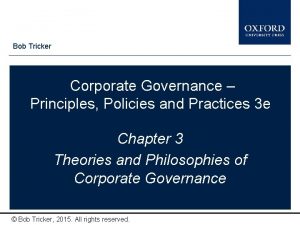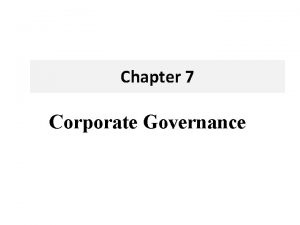Corporate Governance Ondej stek www econ muni cz
























- Slides: 24

Corporate Governance Ondřej Částek

www. econ. muni. cz Content 1. 2. 3. 4. Owners` status Owners` expectations Owners` power (and its application) Corporate governance models 2

www. econ. muni. cz Owners` status Owners Creditors Employees Business Suppliers Customers State 3

www. econ. muni. cz Differences according to the type of business entity n Sole proprietorship n Limited/unlimited liability n Partnerships/companies/corporations 4

www. econ. muni. cz Different expectations of owners The motivation to do business is not always the same. While for some the main incentive can be the profit, others prefer stability, some want to carry on a family tradition or for some it can be a form of self-realization. 5

www. econ. muni. cz Differences in use of the power Depends on: n Participation of owners on managing the company n Structure of the key players n Ownership structure 6

www. econ. muni. cz Participation of owners on managing the company n Fully involved in sole proprietorship businesses n Fully involved in companies with unlimited liability, but not necesserily all owners n Markedly less involved in limited liability companies n Rarely involved in corporations n Sometimes we talk about managerial ownership 7

www. econ. muni. cz Structure of the key players n Owners are the statutory and managing body in sole proprietorships and often in unlimited liability companies n Partnership agreement (and law) can determine differently n Corporate governance laws define the distribution of rights and responsibilities among participants in corporations n The ownership and management are definitely separated 8

www. econ. muni. cz Ownership structure Important features of ownership structure are n Ownership concentration n Type of owner n Natural person n Institutional: investment funds, banks, state, municipalities, other companies n Domestic, foreign 9

www. econ. muni. cz Corporate Governance models Three basic models are used in developed economies: 1. Anglo-american (aka Anglo-Saxon model) 2. Continental (often called German model) 3. Japanese 10

www. econ. muni. cz Anglo-american model So-called one-tier, or external control model General meeting elects the Board of Directors (Bo. D) - part of them are insiders (executive directors), part of them outsiders (non-executive or independent directors) - Bo. D chairman is often also CEO Required are liquid stock markets and low ownership concentration Control is exercised, among others, through the exit system Until recently, laws against close connections between companies and their banks in the USA 11

www. econ. muni. cz Ownership pattern In 1990, institutional investors held approximately 61 percent of the shares of UK corporations, and individuals held approximately 21 percent. (In 1981, individuals held 38 percent. ) In 1990, institutions held 53. 3 percent of the shares of US corporations. 12

www. econ. muni. cz Trends and issues n Growing share of institutional owners, decreasing share of individuals n Voting behavior of institutional owners at AGMs n Concentration of power in the hands of one person or small group of persons n Excessive executive compensation n Regulatory framework reacts 13

www. econ. muni. cz Interactions among key players Elect Shareholders Board of Directors (Supervisor) Stakeholders Appoints and supervises Officers (Manager) Creditors Monitors Manage & regulates Company Regulatory/Leg al system 14

www. econ. muni. cz Continental model So-called two-tiered model, or internal control model General meeting elects supervisory board and management board - in some countries supervisory board names members of management board - it is common that part of the supervisory board is elected by employees (up to 50%, sometimes depend on the firm size) Management board is the statutory body and is responsible for „daily“ management of the company, supervisory board si responsible for the strategic control. Control is exercised, among others, through the voting system. The connection between the company and a bank can be very close. 15

www. econ. muni. cz Ownership pattern Banks Pension funds Other companies Individual owners Foreign investors 27% 3% 41% 4% 19% 16

www. econ. muni. cz Trends and issues n The ownership concentration still increases n Capital markets are illiquid n therefore capital allocation is not perfect n European commission wants to encourage individuals to invest in securities n however the typical european behavior saved EU from larger impact of 2008 financial crisis 17

www. econ. muni. cz Interactions among key players Appoint up to 50% Supervisory Board Appoint 50% Appoint and supervises Employees and Labour unions Management Board Shareholder Manage Own Company 18

www. econ. muni. cz Japanese model So-called Keiretsu. Model with even higher interconnectedness among the key players than the continental model. The key players are: 1. Main bank (a major inside shareholder) 2. Affiliated company or affiliated keiretsu (a major inside shareholder) 3. Management 4. Government 5. Outside shareholders 6. Independent (external) directors Typical is very high ownership concentration and cross-shareholding 19

www. econ. muni. cz Ownership pattern Banks + insurance companies Other companies Foreign investors 43% 25% 3% 20

www. econ. muni. cz Trends and issues Very non-transparent for outsiders Very rigid The strong crossholdin of equity and debt and strong business relationships can woek in favor of competitiveness, but also against it 21

www. econ. muni. cz Interactions among key players Appoint Supervisory Board (including President) Provides managers, monitors and acts in emergencies Provides managers Ratifies the President’s decision President Consults Shareholders Main bank Executive Management (Primarily Board of Directors) Managers Own Provides Loan Company Owns 22

www. econ. muni. cz Thank you for your attention 23

www. econ. muni. cz Sources Graphics (interactions among key players, 3 x) borrowed from Dushyant Maheshwari`s lecture Models of Corporate Governance, retrieved from Slide. Share Ownership patterns data obtained from Joy Clarisse Dagala`s Chapter 4: Models of Corporate Governance, retrieved from Slide. Share 24
 Goal of corporate finance
Goal of corporate finance Econ muni harmonogram
Econ muni harmonogram Scheinův model organizační kultury
Scheinův model organizační kultury Thesis muni
Thesis muni Stek audit
Stek audit De stek castenray
De stek castenray Ondej
Ondej Ondej
Ondej Ondej
Ondej Ondej
Ondej Ondej
Ondej Ondej
Ondej Ondej
Ondej Ondej
Ondej Introduction of corporate governance
Introduction of corporate governance Corporate governance and economic growth
Corporate governance and economic growth Objective of corporate governance
Objective of corporate governance Oecd guidelines on corporate governance
Oecd guidelines on corporate governance Bob tricker corporate governance
Bob tricker corporate governance Latar belakang munculnya good corporate governance
Latar belakang munculnya good corporate governance Hp corporate governance
Hp corporate governance Corporate governance in strategic management
Corporate governance in strategic management Driving forces of csr
Driving forces of csr Corporate governance clause 49
Corporate governance clause 49 Insider and outsider system of corporate governance
Insider and outsider system of corporate governance











































